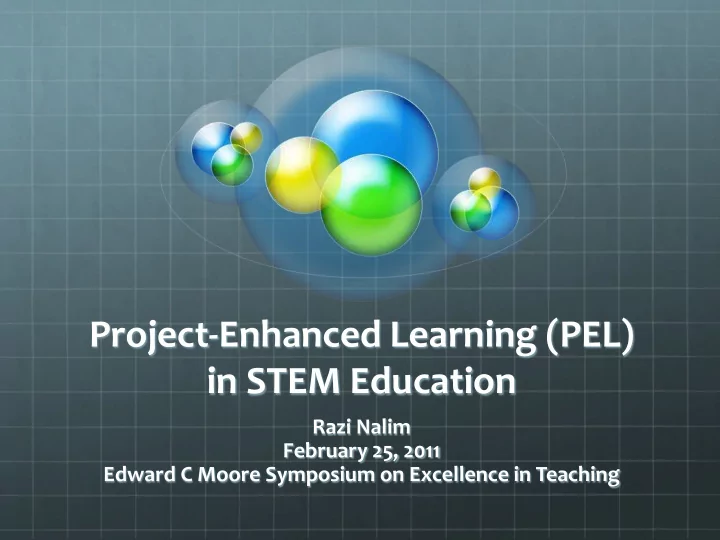

Project-Enhanced Learning (PEL) in STEM Education Razi Nalim February 25, 2011 Edward C Moore Symposium on Excellence in Teaching
Workshop Goals Enhance learning in ‘hard’ and ‘gateway’ STEM courses Which of your courses need this? Discuss PEL and PBL philosophy and goals Principles and practice of PEL Example from ME 200 Thermodynamics Group action: Create a project in your course
Why Change? “ β ρ π σ = better engine” “Why am I here?” $$ Retention of IUPUI Engineering Students Guess what, our students don’t like it either. Only a quarter of all entering freshmen live on campus. They don’t get time or space to work together.
Project & Design Experience in Today’s Engineering Curriculum Freshman experience AND Senior Project experience, separated BY theoretical sciences – needs a bridge F reshman DO projects in themed learning communities . Then wait till their senior year to apply their skills in a capstone project. Sophomore/Junior abstract, mathematical topics are particularly challenging
Problem-Based Learning Problem-Based Learning is a student-centered instructional strategy PBL is driven by challenging, open-ended, ill-defined and ill-structured problems. Students generally work in collaborative groups. Teachers take on the role as "facilitators" of learning
Project-Based Learning Emphasizes authentic ‘real-life’ activities that engage student interest. Provokes students to grapple with the central concepts and principles of a discipline. Teaches skills in communication, organization, research, reflection skills, team-work, leadership. Allows students to generate ideas, exercise voice and choice, and make decisions.
Project-Enhanced Learning Enhances and motivates learning of fundamental concepts Integrates and anchors topics on mental ‘scaffold’ Include most challenging course topics Efficient, minimal extra workload Balance between structure and creativity, NOT VERY open- ended Project framework similar to professional engineering practice (‘real world’ context) Report format consistent with professional practice.
Traditional Thermo Course Unit Conversions Sequential lecture topics - theory first, then applications). 1 st Law Students attempt to piece 2 nd Law the abstract topics together (solving disparate homework Carnot Cycle problems). Power plants, Engines Exciting applications that integrate the concepts come Refrigeration Cycle in the last few hurried lectures. Heat Pump Cycle
Project-Based Course Project assigned on first day of class – meaningful goals, but no idea yet how to do it or what knowledge is needed. Topics introduced in the context of the project, so students are waiting to hear more about thermodynamics! Students see an integrated picture of the topics in the context of their application to the project. Students are introduced to some engineering economics! Unit Conversions Refrigeration Cycle Engineering Economics Carnot Cycle 1 st Law 2 nd Law Heat Pump Cycle Power plants, …
Motivational Illustrate how new theories, concepts, laws, math analysis are necessary to achieve project outcome motivates learning of concepts and theory Illustrate how project meets human needs in the ‘real world’ excites interest, encourages ‘ownership’ In 25+ semesters of assigning essentially the same project (different data), NO evidence of plagiarism
Enhanced interactivity reveals hidden student misconceptions Using on-line project forum, students ask questions: Student Q#1: “Are we to assume that the energy input rate from human metabolism during summer is -1500 Btu/hr and +1500 Btu/hr for winter? Because in summer it'd be adding heat when you are trying to cool the house and vice versa for the winter conditions...” Student Q#2: “A lot of the air conditioning units and furnaces are measured in BTU's. Is that BTU's per day, per hour? Or do we need to convert our heat from BTU/hr to BTU?” Students answer other students’ questions like this! Student A: “Most of the AC units and the furnaces we looked up (mainly on Bryant's website) have the heating/cooling capacities listed in BTUH, which in their glossary is defined as Btu/hr. They also use "ton" in some of their units which is defined as 1 ton = 12000 Btu/hr. So we think it should be pretty straight forward after you have your Q for furnaces/air conditioners.”
Group Activity Choose a partner Chat about your related experiences Exchange course syllabi Imagine a project in one course Meaningful and exciting to students Feasible to complete Outline the project tasks
Include Challenging Course Topics Include the most challenging topics; not necessarily every topic in the course Integrate multiple problems to design one ‘complete’ product, process or system Organize project into sequential assignments loosely synchronized with concepts taught Let students focus on tasks that maximize learning course topics
Trim Burdens, Make it Fun Simplify aspects of project that are outside the course topics, more advanced, or tedious; retain realism provide the needed pieces or data or assumptions show sources of ‘real-world’ data Reduce traditional HW, if overlapped by project problem-solving. Keep HW concepts that are not used in the project. Replace one regular homework question with one that is related to the project in all homework sets, if possible.
Trim Burdens, Make it Fun Minimize instructor burden and limit project scope Assign same project to all students but with different data Work out solutions in advance, possibly on a spreadsheet Balance between open creativity and feasible completion Use discussion forum and involve student TAs / industry professionals to participate Consult early with the CTL to enhance student involvement. More student discussions early on good reports reduced instructor burden towards the end of class.
Build professionalism and communication skills Require structure, timeline, milestones Incorporate report writing and class presentation enhance ownership, professionalism and communication skills Suggestion: Invite industry/community speaker to give a brief (live/ pre-recorded) presentation on real-world project management in your field.
Tips for Assessment Select at least one exam/ quiz question that tests students on basic concepts related to the project but in a different application. Record student scores on individual questions on homework, quizzes,exams etc. Announce Discussion Forum early in class and include a motivator (e.g., 2 homework pts. for each meaningful participation).
Recommend
More recommend